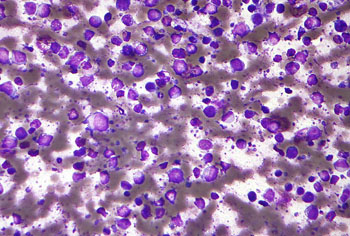Personalized Cancer Diagnostics Based on Circulating Tumor DNA Profiling
By Gerald M. Slutzky, PhD
Posted on 22 Nov 2016
Cancer researchers have demonstrated that profiling of circulating tumor DNA (ctDNA) revealed molecular determinants that enabled them to predict adverse outcomes in patients with diffuse large B cell lymphoma and that could be developed into a method for personalized diagnosis.Posted on 22 Nov 2016
Diffuse large B cell lymphoma (DLBCL) is a relatively common type of tumor that can exhibit a wide range of behaviors, from asymptomatic and curable cancers to ones that are very aggressive and difficult to treat. Investigators at Stanford University (Palo Alto, CA, USA) hypothesized that characterization of mutational heterogeneity and genomic evolution using circulating tumor DNA (ctDNA) profiling could reveal molecular determinants that would enable them to classify tumors as to their likely clinical outcome.

Image: A micrograph of a diffuse large B cell lymphoma (DLBCL) (Photo courtesy of Wikimedia Commons).
To this end they applied CAncer Personalized Profiling by deep Sequencing (CAPP-Seq) analysis to tumor biopsies and cell-free DNA samples from 92 lymphoma patients and 24 healthy subjects. CAPP-Seq is a sensitive method used to quantify DNA in cancer. It measures cell-free tumor DNA, which is released from dead tumor cells into the blood. This method can detect one molecule of mutant DNA in 10,000 molecules of healthy DNA. CAPP-Seq targets specific areas of the genome that are recurrently mutated for a given cancer. It can also target multiple areas of the genome at once and a variety of different types of mutations, allowing for a lower amount of input DNA compared to other methods.
The investigators reported that at diagnosis low levels of ctDNA correlated strongly with progression-free survival in the patients, but that those with higher levels of ctDNA faired more poorly overall. They demonstrated that ctDNA genotyping could classify transcriptionally defined tumor subtypes, including DLBCL cell of origin, directly from plasma. By simultaneously tracking multiple somatic mutations in ctDNA, their approach outperformed immunoglobulin sequencing and radiographic imaging for the detection of minimal residual disease and facilitated noninvasive identification of emergent resistance mutations to targeted therapies. In addition, they identified distinct patterns of clonal evolution distinguishing indolent follicular lymphomas from those that transformed into DLBCL.
The results suggested that there were at least five ways that analysis of circulating tumor DNA could yield potentially clinically useful information: by quantifying tumor burden, identifying disease subtype, cataloging mutations, predicting transformation, and providing early warnings of recurrence.
"Now we can identify the subtype of the tumor, watch how it changes over time, and begin to tailor our chemotherapy choices based on the presence or absence of specific mutations," said senior author Dr. Ash Alizadeh, assistant professor of medicine at Stanford University. "We have moved beyond just measuring disease burden based on the amount of tumor DNA in the blood."
The study was published in the November 9, 2016, online edition of the journal Science Translational Medicine.
Related Links:
Stanford University













